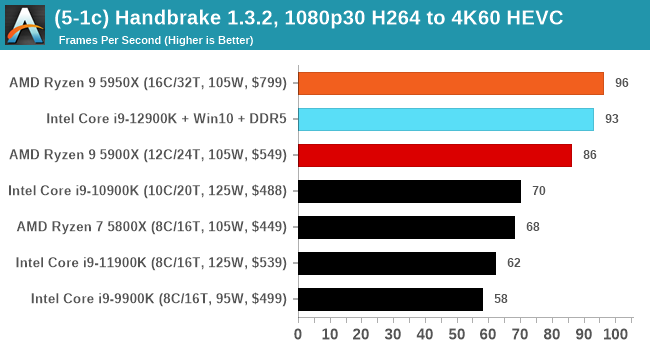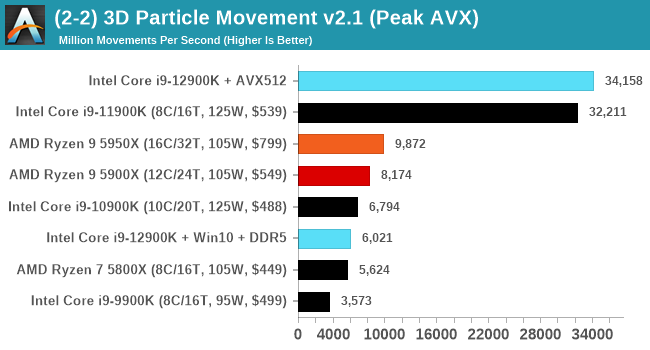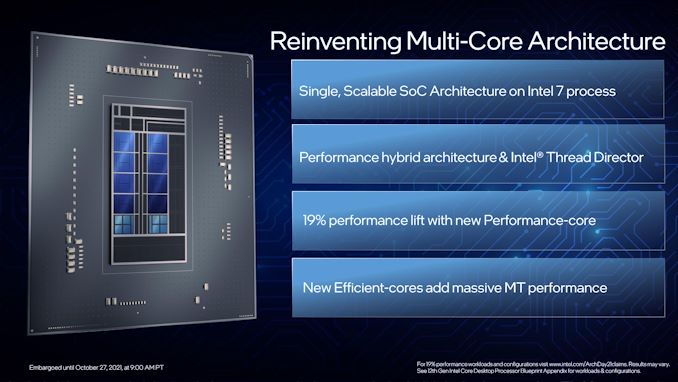The Intel 12th Gen Core i9-12900K Review: Hybrid Performance Brings Hybrid Complexity
by Dr. Ian Cutress & Andrei Frumusanu on November 4, 2021 9:00 AM ESTConclusion: Variables Maketh the CPU
Suffice to say, Intel’s new 12th Generation Core family has added more variables to the mix than a traditional processor launch. The combination of different types of core, coming at a time where a new operating system has just been launched, but also at the inflection point of a new type of memory. Let’s break down some of the differences we’ve observed in our testing.
When we compare Windows 10 to Windows 11, purely on throughput benchmarks, we don’t find much difference. There are a few spots where Windows 11 has a slight advantage in multi-threaded workloads, but this comes down to how new threads are spawned between the performance cores and the efficiency cores. Intel stated that the performance between the two, at least for CPU workloads, should be within a few percentage points, stating that Windows 11 should have lower run-to-run variance. We can corroborate this in our testing. Windows 10 also had some scheduling issues with low priority threads, which we expect to be ironed out with updates.
Comparing the new DDR5 to the old DDR4 is a different story, as the new memory standard offers a substantial uplift when it comes to memory bandwidth. As we saw recently with the M1 Max review, sometimes memory bandwidth can be a limiting factor. In our testing, DDR5 had a minor lead in single threaded tests but in a lot of multithreaded tests, the lead was significant. For real world, we had examples of +14% in Agisoft, +10% in NAMD, +8% in V-Ray, +10% in Handbrake, and +20% in WinRAR. In SPEC2017, we saw a couple of single threaded workloads get +15% improvements over DDR5, but in multi-threaded this was up to +40% on average, or more than 40% in specific tests. This also comes down to the doubled memory channels (4x32-bit vs 2x64-bit) which can be better utilized on top of the bandwidth increases.
Now comparing the P-core to the E-core, and it’s a story of how the E-core individually can perform on par with a Skylake core. Having eight extra Skylake-class cores is nothing to be sniffed at. In a lot of tests the E-core is half the performance of the P-core, but the P-core is itself is now the market leader in performance. The Golden Cove core inside Alder Lake has reclaimed the single-threaded performance crown with an uplift in SPEC of 18-20%, which is in line with Intel’s 19% claim. This puts it ahead of Apple’s M1 Max or 6% (int) and 16% (fp) ahead of AMD’s Zen 3 core.
The Core i9-12900K
Combining fast P-cores, Skylake-class E-cores, and DDR5 into one package means that Intel has certainly jumped from behind the competition to in front of it, or at least in the mix. When you have your operating system set up just right, and no issues with schedulers, it outperforms AMD’s offering when single core performance matters, and in multi-threaded workloads, it does tend to sit somewhere between a 5900X and a 5950X.

It’s important to note that in some tests, the Core i9-12900K does win outright. It’s at this point we should consider how much is core related vs standards related: DDR5 has produced somewhat of an uplift, and the competition is expected to claw some of that back when they introduce it, but those products are expected more towards the latter half of 2022. For users with those specific workloads today, and willing to pay the DDR5 early adopter tax, Alder Lake can provide performance uplifts right now.

Power is an interesting topic, and although our peak power numbers when all cores were loaded were above the 241W Turbo power on the box, in real world workloads it didn’t tend to go that high. The P-cores alone on the chip matched the power consumption of Intel’s 11th Generation in AVX2 workloads, but adding in the E-cores does put it over the previous generation. I’m not entirely sure what that says about Intel’s 7 manufacturing process compared to the 10SF used before. A lot of the performance gains here appear to come from IPC and DDR5, and that doesn’t seem to have come with performance per watt gains on the P-cores. It means that Intel is still losing on power efficiency at load compared to the competition.

I have to say a side word about AVX-512 support, because we found it. If you’re prepared to disable the E-cores, and use specific motherboards, it works. After Intel spent time saying it was fused off, we dug into the story and found it still works for those that need it. It’s going to be interesting to hear how this feature will be discussed by Intel in future.
Overall though, it’s no denying that Intel is now in the thick of it, or if I were to argue, the market leader. The nuances of the hybrid architecture are still nascent, so it will take time to discover where benefits will come, especially when we get to the laptop variants of Alder Lake. At a retail price of around $650, the Core i9-12900K ends up being competitive between the two Ryzen 9 processors, each with their good points. The only serious downside for Intel though is cost of switching to DDR5, and users learning Windows 11. That’s not necessarily on Intel, but it’s a few more hoops than we regularly jump through.











474 Comments
View All Comments
mode_13h - Saturday, November 6, 2021 - link
> Consumers deserve non-broken products that aren’t sold via smoke and mirrors tactics.What's broken, exactly? They said you wouldn't have AVX-512. That someone figured out how to enable it is just bonus.
mode_13h - Saturday, November 6, 2021 - link
Why are you convinced it's so consequential?mode_13h - Saturday, November 6, 2021 - link
Oops, that was a response to:OG> The current situation is inexcusable.
Oxford Guy - Sunday, November 7, 2021 - link
That question is meritless.mode_13h - Sunday, November 7, 2021 - link
If the issue isn't terribly consequential, then why is it inexcusable? The gravity of alleged misconduct usually derives from its impacts.Oxford Guy - Monday, November 8, 2021 - link
I have been suspicious that you’re some sort of IBM AI. Posts like that go a long way toward supporting that suspicion.You were the poster who claimed it’s of little consequence. I was the poster who said it’s inexcusable. Either you’re AI that needs work or your mind is rife with confusion in your quest to impress the community via attempts at domination.
Not a good look, again. Posting your own claims as if they’re mine and using my claims to create a false incompetence situation is a bit better than your pathetic schoolyard taunts. So, perhaps I should praise you for improving the quality of your posts via being merely incompetent — like Intel’s handling of this situation you’re trying to downplay. I shouldn’t make that equivalence, though, as lying to the community in terms of a retail product is worse than any of your parlor tricks.
mode_13h - Tuesday, November 9, 2021 - link
> I have been suspicious that you’re some sort of IBM AI.No way. Their artificial intelligence is no match for my natural stupidity.
:D
> You were the poster who claimed it’s of little consequence.
No, I asked *you* why it's so consequential.
> I was the poster who said it’s inexcusable.
Which sort of implies that it's very consequential. If it's of not, then why would it be inexcusable?
> Either you’re AI that needs work or your mind is rife with confusion in your quest to
> impress the community via attempts at domination.
If you wouldn't waste so much energy posturing and just answer the question, maybe we could actually get somewhere.
I don't honestly care what the community thinks of me. That's the beauty of pseudonymity! I don't even need people to believe I'm somehow affiliated with a prestigious university. Either my points make sense and are well-founded or they aren't. Similarly, I don't care if you're "just" the Oxford garbage collector. If you contribute useful information, then we all win. If you're just trolling, flaming, or pulling the thread into irrelevant tangents, then we all lose.
The main reason I post on here is to share information and to learn. I asked what should be a simple question which you dismissed as meritless, and without explaining why. As usual, only drama ensues, when I try to press the issue. I always want to give people the opportunity to justify their stance, but so often you just look for some way to throw it back in my face.
This kind of crap is extremely low value. I hope you agree.
mode_13h - Saturday, November 6, 2021 - link
> and the sentence about how it could be eliminated in the future.It's true. Intel can disable instructions in microcode updates and in future steppings of the CPU. So, even having the BIOS option is no guarantee.
mode_13h - Saturday, November 6, 2021 - link
> Since the silicon is there, if they can get the scheduler to manage> heterogeneous (P/E) cores there is now no down side with enabling AVX-512.
This will not happen. The OS scheduler cannot compensate for lack of app awareness of the heterogeneous support for AVX-512. I'm sure that was fiercely debated, at Intel, but the performance downsides for naive code (i.e. 99%+ of the AVX-512 code in the wild) would generate too many complaints and negative publicity from the apps where enabling it results in performance & power regressions.
Oxford Guy - Saturday, November 6, 2021 - link
So, Alder Lake is a turkey as a high-end CPU, one that should have never been released? This is because each program has to include Alder Lake AVX-512 support and those that don’t will cause performance regressions?So, Intel designed and released a CPU that it knew wouldn’t be properly supported by Windows 11 — yet the public was sold Windows 11 primarily on the basis of how its nifty new scheduler will support this CPU?
‘The OS scheduler cannot compensate for lack of app awareness of the heterogeneous support for AVX-512’
Is Windows 11 able to support a software utility to disable the low-power cores once booted into Windows or are we restricted to disabling them via BIOS? If the latter is the case then Intel had the responsibility for mandating such a switch for all Alder Lake boards, as part of the basic specification.